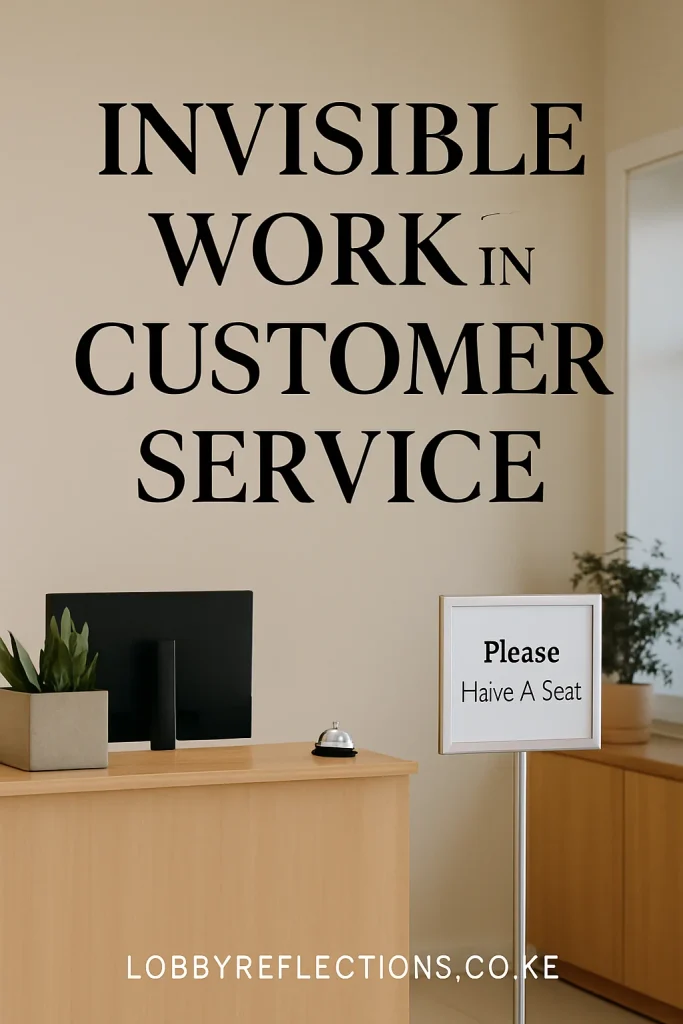
You’re not working.”
That statement hit hard. It was a Thursday afternoon when my supervisor at the insurance firm summoned me to his office. I had walked into that meeting with a clear conscience and walked out questioning my value.
“Your numbers don’t reflect work,” he said.
But whose numbers were they, really?
My role involved receiving walk-in clients, resolving complaints, coordinating with departments, and submitting weekly reports on new policy registrations. But those numbers weren’t based on how well I served customers — they were based on the number of policies brought in by our agents. If they had a slow week, I looked unproductive, no matter how many angry clients I calmed or forms I followed up on.
That’s when I first understood the weight of invisible work in customer service.
What Is Invisible Work in Customer Service?
Invisible work refers to the effort you put in that isn’t captured by formal metrics, KPIs, or end-of-week dashboards. In customer care, this includes everything from smiling at a frustrated client to rearranging the lobby to make it welcoming — none of which shows up in a report.
These tasks may not generate revenue directly, but they create the environment where business thrives. Yet, they often go unnoticed unless something goes wrong.
Real-Life Examples: Insurance Firm and Church Office
📌 Insurance Office – Reports That Missed the Real Work
Each week, I prepared and submitted performance reports. But here’s the twist: my report performance was tied to the agents’ output, not my customer service efforts. So, if an agent brought in zero new clients, my work looked like zero — even if I had spent the entire week solving client issues, updating forms, and following up on claims.
And then came the review: “You’re not working.”
But I had been working — quietly, effectively, and consistently.
📌 Church Office – Systems From Scratch
Later, as the first secretary in a growing church, I had the chance to build things from the ground up. I created Excel spreadsheets for tracking income and expenditure, managed petty cash, and filed weekly reports to maintain accountability. I also ensured the lobby was neat, that chairs were arranged, visitors welcomed, and supplies restocked.
No one trained me. No one told me to do it. But I saw the gaps and filled them.
Still, much of that work remained invisible unless someone asked, “Who did this?”
What Customer Care Really Looks Like Behind the Desk
Here’s a short list of daily duties many customer care workers perform that go unnoticed:
- Rearranging chairs in the lobby every morning
- Wiping down the reception desk
- Offering tea or water to guests
- Replacing forms on notice boards
- Calming down irate clients and de-escalating tension
- Updating internal lists, registers, or trackers
- Double-checking files before handing them over
- Directing lost visitors with patience
These aren’t flashy tasks — but without them, chaos would creep in.
“Customer care isn’t always about solving problems. Sometimes it’s about preventing them from ever happening.”
How to Track Invisible Work and Prove Your Value
After the “you’re not working” moment, I started documenting everything.
A friend had once told me, “Keep a daily log. Not for your boss — for yourself.”
That advice saved me.
Every day, I noted:
- How many clients I attended to
- What complaints I handled
- What documents I processed
- Any extra tasks I took on
Eventually, I began emailing short weekly summaries to my supervisor — a subtle form of accountability. When performance reviews came around, I had proof of effort.
Tools I used to track my invisible work:
🗒️ Daily Work Journal – Amazon Affiliate Link
📊 Custom Excel templates (created for church admin)
📌 Sticky notes and physical to-do lists
You don’t need fancy tools. You just need consistency.
Why Invisible Work Matters
Invisible work is the foundation that keeps customer-facing businesses running smoothly. Here’s why it matters:
✅ Reduces complaints: You prevent chaos by being proactive
✅ Builds trust: Clients feel cared for, even if they don’t say it
✅ Strengthens your reputation: Internally and externally
✅ Saves time and money: Systems like trackers reduce errors
Yet, because it’s not always measurable, it’s easy for managers to overlook.
That’s why self-tracking and advocating for yourself are essential.
What Employers and Team Leads Should Know
If you manage customer-facing staff, here’s how to recognize and reward invisible work:
🔹 Align KPIs with actual tasks, not just outcomes
🔹 Use customer feedback forms to collect input
🔹 Pay attention to order, cleanliness, and customer flow
🔹 Encourage weekly self-assessments or check-ins
🔹 Praise proactive problem-solving — not just target-hitting
A smooth day for the manager is often because of the effort the customer care rep put in behind the scenes.
Final Thoughts: Own Your Work — Seen or Unseen
There are days when you’ll do everything right, and no one will notice.
There are moments when your best work is invisible.
But that doesn’t make it less valuable.
Whether you’re rearranging chairs, balancing petty cash, or calming a client whose policy lapsed unfairly — your work matters.
So the next time someone tells you, “You’re not working,” take a breath.
Then open your journal, your logbook, your memory.
And remind yourself: I am working. I always have been.
💬 What About You?
Have you ever had your work overlooked just because it wasn’t “measurable”?
How do you keep track of the small things that make a big difference?
Share your experience in the comments or tag #InvisibleWork #LobbyReflections on LinkedIn.
This post may contain affiliate links. If you purchase through them, I may earn a small commission at no extra cost to you. Thank you for supporting Lobby Reflections!
📍 Also Read: Handling Unstable Customers in Customer Care
Leave a Reply